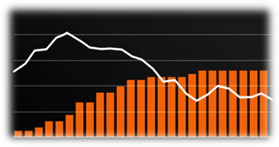Canada became the first G7 nation to cut its key interest rate by 25-basis points on June 5th, from 5% down to 4.75%, signalling a shift in monetary policy which saw rates jump in the past two years due to very grim global economic factors. In that time, Canadians saw rising costs which impacted not only businesses big and small, but also the average consumer who could no longer afford to pay their rent or mortgage payments, or in many cases had to choose between keeping the lights on or putting food on the table. Histor ically, these rates are not high when compared to the 1970s or 1980s – remember 21% rates anyone? – but there was a sense of shock and awe to those businesses and consumers who were unprepared.
ically, these rates are not high when compared to the 1970s or 1980s – remember 21% rates anyone? – but there was a sense of shock and awe to those businesses and consumers who were unprepared.
In broad terms, Statistics Canada reported on June 5th that Canada’s annual inflation rate slowed to 2.9%, lower than an annual rate of 3.4% a month earlier. However, upon taking a closer look at the slowing inflation rate, this number included what is known as “shelter inflation” which includes mortgage interest costs. Below shows the types of shelter costs included in the Canadian inflation numbers:
Exhibit 1: Shelter Inflation in Canada
| Source: Statistics Canada, TD Economics. | ||
| Current Annual Inflation Rate | Weight in Shelter Index | |
| Total Shelter Inflation | 6.2% | |
| Rent Accommodation | ||
| – Rent | 7.9% | 24% |
| Owned Accommodation | ||
| – Mortgage Interest Costs | 27.4% | 13% |
| – Homeowners’ Replacement Cost | -1.6% | 19% |
| Water, Fuel, and Electricity | 0.6% | 12% |
The relationship here is that when inflation is high, bank rates may rise thus causing borrowing costs to increase. Further to that, costs such as mortgage interest account for a significant weighting within the consumer price index (CPI) basket, which is a key component in determining whether to increase rates, keep rates flat or to lower them.
James Orlando, who is a Director and Sr. Economist at TD Economics has said that “the country has experienced a huge population growth amid low housing supply leading to record low vacancy rates spurring increased rent inflation due to supply and demand imbalances.[1]” He says that if the Bank of Canada cuts rates, the supply-demand imbalance that currently exists won’t be fixed. He notes that if the Bank of Canada continues to focus on metrics that include shelter costs, “Canadians will suffer under the weight of high-interest rates.[2]” Given this argument, what does the interest rate cut really do for businesses and our community at large?
Let’s put this into perspective.
I stated earlier that costs rose exponentially which hurt the average business and in turn hurt the average household. Brampton was no exception. In as much as the cut is a positive sign for all consumers, it’s certainly not a game changer. My hypothesis, a working theory if you will, is that costs will not decrease at the rate in which they increased. The factors that contribute to the inflated costs of goods that are causing businesses and consumers distress have much more to do with global supply chain factors than what’s happening in Canada. In this vein, I argue that costs will decrease at a much slower rate and thus, consumers will experience the Paradox of Thrift. This theory, made famous by John Maynard Keynes, states that if consumer prices are allowed to fall consistently because of an increase in productivity, consumers learn to hold off on their discretionary spending purchases and wait for a better deal. We have seen this of course in the housing market, or at the grocery stores where consumers are visiting their local Farmer’s Market more than their regular No Frills or Food Basics, or even in other discretionary spending items where you become just a budget line for membership to organizations. Of no doubt, lowering rates will cause productivity to increase as businesses won’t feel the squeeze and the burden of increased carrying costs. But that may not necessarily mean that consumers will be ready to spend right away.
This argument is supported by Stephen Tapp, chief economist at the Canadian Chamber of Commerce, who says, “Labour productivity has now fallen in 12 of the last 15 quarters coming out of the pandemic. The level of Canada’s labour productivity is now back to where it was in 2018, which means we’ve had no growth over a span of six years.[3]” Taking a step back and acknowledging that interest rates are a blunt policy instrument, solutions to increasing productivity might require innovative fiscal policies and more industry leading policies from the federal government to spur productivity in specific sectors of the economy. Perhaps activities to consider include cutting red tape, easing internal trade barriers, or focusing on using immigrant skills in a better more effective manner. For this of course, we need a Government that will think broadly to adopt new technologies and find innovative solutions to attract investment. Stay tuned to the issues raised during the next Federal Election campaign!
 A more specific consideration to make is will this cut make an impact on business owners at large, will it be in favour of certain sectors over others, or will it cause a net zero effect in the community and for consumers? For instance, homeowners with a variable mortgage rate will see their rates decrease but it won’t provide them with the material relief needed to battle other costs. Now imagine a business, or a person or a family who is struggling with affordability in general. According to Meaghon Reid of Vibrant Communities Calgary, the rate cut although encouraging, means that “it can still be frustrating for those struggling to make ends meet as the effect on daily living costs will be negligible.[4]” To add credibility to that thesis, Anne Arbour with the Credit Counselling Society says that things such as groceries, gas and the other pieces of day-to-day inflation are still going to affect people’s spending and “given the way groceries and gas are now, it’s getting tighter and tighter and they (consumers) are not necessarily able to have the flexibility they had before.[5]”
A more specific consideration to make is will this cut make an impact on business owners at large, will it be in favour of certain sectors over others, or will it cause a net zero effect in the community and for consumers? For instance, homeowners with a variable mortgage rate will see their rates decrease but it won’t provide them with the material relief needed to battle other costs. Now imagine a business, or a person or a family who is struggling with affordability in general. According to Meaghon Reid of Vibrant Communities Calgary, the rate cut although encouraging, means that “it can still be frustrating for those struggling to make ends meet as the effect on daily living costs will be negligible.[4]” To add credibility to that thesis, Anne Arbour with the Credit Counselling Society says that things such as groceries, gas and the other pieces of day-to-day inflation are still going to affect people’s spending and “given the way groceries and gas are now, it’s getting tighter and tighter and they (consumers) are not necessarily able to have the flexibility they had before.[5]”
If my working theory is indeed supported by both the quantitative and qualitative arguments put forth by community-based organizations and by those in the finance community, then I suspect that this rate cut is not going to have an immediate impact on the economy as some might be anticipating. Although it will benefit some, and although I do agree that it is a positive step in the right direction, it will take a series of cuts as well as positive outcomes from other outside factors to really make an impact on the everyday lives of business owners and the average consumer. Time will tell whether Canada taking the lead on cutting rates will pan out and work in our favour but until then, let’s enjoy the moment for what it is.
[1] https://www.bnnbloomberg.ca/boc-should-start-looking-past-the-influence-of-shelter-inflation-economist-1.2036922
[2] https://www.bnnbloomberg.ca/boc-should-start-looking-past-the-influence-of-shelter-inflation-economist-1.2036922
[3] https://financialpost.com/news/economy/productivity-decline-bank-of-canada-cuts-interest-rates
[4] https://calgaryherald.com/news/local-news/rate-cut-welcome-limited-impact-affordability
[5] https://vancouver.citynews.ca/2024/06/06/interest-rate-cut-purchases-counsellor-caution/
